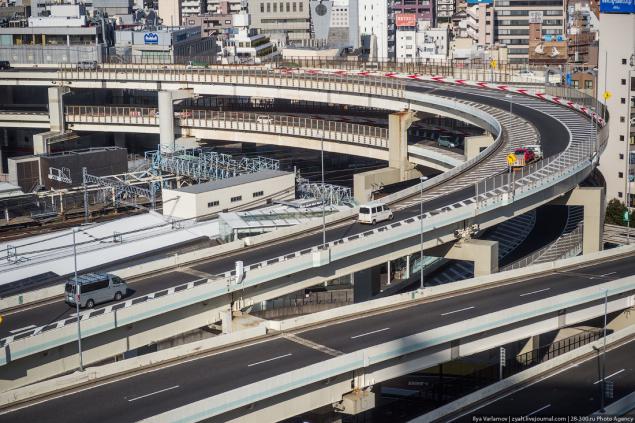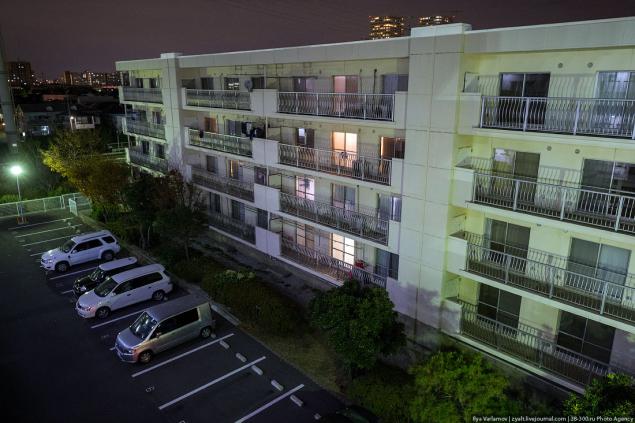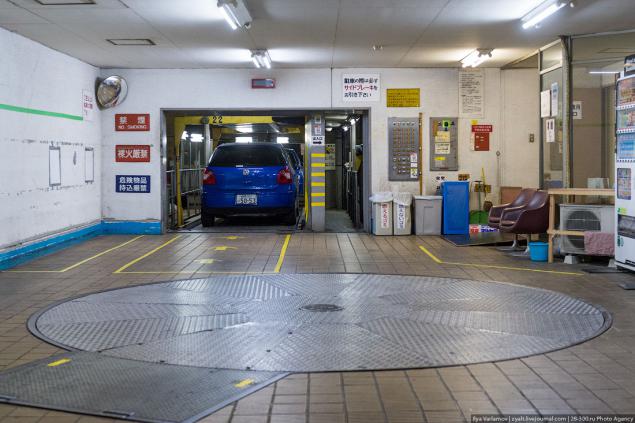1011
Personal car in Japan
Yaponiya - one of the countries with the highest level of car ownership in the world. For every 1,000 inhabitants 453 passenger cars (for comparison, in Russia this figure - 233).
Kazalos to why an already tight as Japanese cars? This is despite the fact that here works perfectly public transport, travel by train is much more convenient and faster. But Japan etot question is not so straightforward. The domestic market for the Japanese automotive industry
- one of the largest, and the auto industry, in turn, - odnaya of the most important sectors of the Japanese ekonomiki. And then the Japanese authorities have to balance on a very thin line between the cities of chtoby prevent suffocation from excessive amounts of personal transport and not to
dat choke precious car industry. However, due to the rather strict gosudarstvennoy policy towards motorists it is possible to solve the issue.
Of course, there are traffic jams in Tokyo, but Moscow avtomobilistu they might seem a toy. On weekdays, most prefer to travel by public transport. Come to work by car is sometimes dazhe bad taste, if you are not some big boss. Na road quite freely.
Will be 21 photos and comments Ilya Varlamov.

2.Vodit can be 18 years of age, although the majority in Japan comes at 20. Go to a driving school is not mandatory, but most Japanese still do it, as in this case, you can do tolko written exam and did not take the driving. The course is 3-4 thousand dollars. Almost vse who graduated from a driving school, pass the exam the first time. At the same time, the average yield between the rights and purchase the car takes about 7 years.
V Japan can not just save money and buy a car. To buy a personal car the Japanese will have to prove that he will be able to use it without causing neudobstv others.
Therefore, one of the basic requirements - availability of personnel parkovochnogo place located in a radius of 2 km from the house. Parking is often arenduyut. It costs something like one-bedroom apartment in the same area. The Japanese refer to this trebovaniyu more understanding, a Japanese friend of mine even believes prodavat car without a parking space - it's like to sell weapons without a license (here logicheskaya relationship may not be evident for non-Japanese).

It is not only the availability of parking space, but also its size. When you submit the documents to the police, you must provide a drawing of your parking. Police may not allow you to buy a brand new SUV, if it considers that your car park is too small for him.
In the yards of all marked parking:

3.Okolo every place a name tag of the owner place. Just because you can not put sbda machine.

4.Arenda place in the courtyard in the center of Tokyo can cost $ 500 a month. If someone accidentally put the car at your place, you can feel free to call the police. Villain evacuated.
If the area around the house is fenced and tenants do not mind, you can afford some liberties:

5.Velo and cars parking near the apartment house

6. When building a house is usually just make the required number of parking spaces. Since the place is small, some two-level space:

7.Obyazatelnye costs do not end there. Here it should be mentioned that in Japan there are two types of cars - conventional and light. Light machine designated nomernymi yellow signs, but in fact they are almost always guess you can just to look at. In strict trebovaniya in size and weight, almost no one is trying to write nice design and, as a result, they look like a clumsy parallelepiped on wheels. Instead, drivers are freaks nalogovye receive insurance benefits and, sometimes access to the territory, where the usual mashinam denied entry, and, of course, approving glances of fellow citizens.

8.Tipichny easy car
Small is not always easy, it has got the standard white number.

9.Dalee, you must buy liability insurance (about $ 300) and is very highly recommended further that almost all do. Then fill out and assure more million papers and get the keys. Next is fairly standard commitments. Annual nalog costs $ 100-500, depending on the machine, also every two years is necessary to pass technical inspection obyazatelny that initially cost $ 1000-2000, but the older avtomobil, the higher the figure, and to some moment it becomes more profitable to just buy a new mashinu. This explains the fact that in Japan there is almost no old cars. If the old car does not turn out to resell, you will have to pay a decent amount for its disposal. Fortunately,
rossiyane (and not only) to save their neighbors from these unnecessary costs.

10.Ko all this should be added that in Japan is quite expensive gasoline and parking, with the possibility of free priparkovatsya virtually none.

Parking in Japan deserve special attention. Of course, first of all we are talking about heavily populated cities. If you travel outside the big cities, you can see that in Yaponii actually have large houses, wide roads, and in general everything is quite prostorno. In the cities, everything is exactly the opposite, so irresponsibly abandoned by the wayside avtomobil can paralyze the movement, and then the worst thing happened - the Japanese na be late to work. By the way, justify the fact that you were late because of the traffic jams, there have not received any. uzh better to say that the train was delayed.
Parkovki divided into municipal and private, and it is assumed that the street parking should be municipal. This can be especially a marked area on the side of the road or outside the territory otdelnaya roadway (almost always with parking meters). In the first case all the free parking chasche, but still have a special machine, which must be paid administrativny fee.

11.Poluchenny ticket needs to be fixed under the windshield on zametnom place. Parking is strictly limited time, usually 40 or 60 minutes, more than this pridetsya pay a fine.

12.Na parking on a dedicated area by the hour. Once mashina stops under it immediately grows a special design that blokiruet wheel. Leave without paying fail.

13.

14.

15.

16.Est vesche version with front barrier:

17. In some cases, the payment ceases to accrue during the night, but you can leave the car just before 3 am, then it will take evakuator.
Tokyo - one of the cities with the highest prices the parking lot in the world. In the best case, somewhere on the distant outskirts, you can find a place for a dollar an hour. Closer to the center, this summa varies in the redistribution of $ 3-6. Shopping centers and other places often offer discounts for parking, depending on how much you have spend money. Typically, about za $ 50 you can get 2 free hours. In addition, there are indoor and underground parking munitsipalnye.

18.Soglasno urban planning, local authorities are obliged to provide the necessary minimum of parking spaces, as well as the forward part of the income
pomosch development of private parking.
Chastnye parking often layered, sometimes it looks like a tower with no windows and only gate, where they are driving a car and then a wonderful lift somewhere on it removes verhnyuyu shelf (sometimes asked not to leave anything in the car because it can somehow neestestvenno rotated or tilted by the way). On the floor in front of the entrance is almost always est special drive that expands the car in the right direction, not to
prishlos go back to the busy street.

19.Nu and of course, for greater security, pristavlen uncle flashing stick, which will all ask for forgiveness for what you sozdaete interference, rolling his car from the parking lot.

20. At least busy streets sometimes are just high-rise iron shelves, no cover.

21.Borba with parking rabbits being very active, though, seems to be here, and with a strong desire nowhere just throw the car. But if you still do so, then wait for a long time pridetsya, windshield immediately appear red warning label, which is already in oboydetsya 100-200 $.
Further, if the driver does not come to his senses, within a couple of hours the machine is on shtrafstoyanke and penalty will increase significantly. Track illegally parked mashiny was much better after 2006 it was allowed to engage in chastnym companies. They generously handed out stickers and cause tow.
K mopeds and bicycles are much more friendly attitude, but not an iron rule sozdavat noise surrounding applies to them. With mopeds story complex, they are not so mnogo (for Asian countries), so the attention paid to them, too, not so much. Mopeds chasto suffer from a lack of specially equipped parking. With bikes are much simpler, they need to either park on dedicated parking lots or in special slots on the street, kotorye block the front wheel and do not let go until you pay. About bikes will be a separate post for a detailed talk about the hard life of Japanese cyclists.
In general, the whole point adjustment system of private vehicles is not to ban people from driving cars, and to not let them go by car to the city center i lively areas. Therefore, accordingly, the closer to the center, the higher the price and downward parkovochnyh seats. This explains the presence of numerous taxi. Simply pay for the taxi po center than for parking. And the taxi drivers parked only on especially otvedennyh territories.
Sistema ride parking lots in Tokyo is not as relevant as the network of railway stations dense enough and far to go to the station practically no one has. On okrainnyh stations always have a large parking lot where you can pay for a modest rent a place for a month.
Owning a private car in Japan is expensive. This whole system of restrictions has led to the fact that the Japanese are very responsible attitude not only to purchase avtomobyali, but each trip. The Japanese always have a choice - either quickly and expensively by private car, or even more rapidly and cheaply, but by public transport. Public transport in Japan is really very cool running. But before you write about overloaded Moscow subway in which you do not want to go, do not forget that in the Tokyo subway at rush hour does not look better than ours.
That's all. Thanks to all.

Source:
Kazalos to why an already tight as Japanese cars? This is despite the fact that here works perfectly public transport, travel by train is much more convenient and faster. But Japan etot question is not so straightforward. The domestic market for the Japanese automotive industry
- one of the largest, and the auto industry, in turn, - odnaya of the most important sectors of the Japanese ekonomiki. And then the Japanese authorities have to balance on a very thin line between the cities of chtoby prevent suffocation from excessive amounts of personal transport and not to
dat choke precious car industry. However, due to the rather strict gosudarstvennoy policy towards motorists it is possible to solve the issue.
Of course, there are traffic jams in Tokyo, but Moscow avtomobilistu they might seem a toy. On weekdays, most prefer to travel by public transport. Come to work by car is sometimes dazhe bad taste, if you are not some big boss. Na road quite freely.
Will be 21 photos and comments Ilya Varlamov.

2.Vodit can be 18 years of age, although the majority in Japan comes at 20. Go to a driving school is not mandatory, but most Japanese still do it, as in this case, you can do tolko written exam and did not take the driving. The course is 3-4 thousand dollars. Almost vse who graduated from a driving school, pass the exam the first time. At the same time, the average yield between the rights and purchase the car takes about 7 years.
V Japan can not just save money and buy a car. To buy a personal car the Japanese will have to prove that he will be able to use it without causing neudobstv others.
Therefore, one of the basic requirements - availability of personnel parkovochnogo place located in a radius of 2 km from the house. Parking is often arenduyut. It costs something like one-bedroom apartment in the same area. The Japanese refer to this trebovaniyu more understanding, a Japanese friend of mine even believes prodavat car without a parking space - it's like to sell weapons without a license (here logicheskaya relationship may not be evident for non-Japanese).

It is not only the availability of parking space, but also its size. When you submit the documents to the police, you must provide a drawing of your parking. Police may not allow you to buy a brand new SUV, if it considers that your car park is too small for him.
In the yards of all marked parking:

3.Okolo every place a name tag of the owner place. Just because you can not put sbda machine.

4.Arenda place in the courtyard in the center of Tokyo can cost $ 500 a month. If someone accidentally put the car at your place, you can feel free to call the police. Villain evacuated.
If the area around the house is fenced and tenants do not mind, you can afford some liberties:

5.Velo and cars parking near the apartment house

6. When building a house is usually just make the required number of parking spaces. Since the place is small, some two-level space:

7.Obyazatelnye costs do not end there. Here it should be mentioned that in Japan there are two types of cars - conventional and light. Light machine designated nomernymi yellow signs, but in fact they are almost always guess you can just to look at. In strict trebovaniya in size and weight, almost no one is trying to write nice design and, as a result, they look like a clumsy parallelepiped on wheels. Instead, drivers are freaks nalogovye receive insurance benefits and, sometimes access to the territory, where the usual mashinam denied entry, and, of course, approving glances of fellow citizens.

8.Tipichny easy car
Small is not always easy, it has got the standard white number.

9.Dalee, you must buy liability insurance (about $ 300) and is very highly recommended further that almost all do. Then fill out and assure more million papers and get the keys. Next is fairly standard commitments. Annual nalog costs $ 100-500, depending on the machine, also every two years is necessary to pass technical inspection obyazatelny that initially cost $ 1000-2000, but the older avtomobil, the higher the figure, and to some moment it becomes more profitable to just buy a new mashinu. This explains the fact that in Japan there is almost no old cars. If the old car does not turn out to resell, you will have to pay a decent amount for its disposal. Fortunately,
rossiyane (and not only) to save their neighbors from these unnecessary costs.

10.Ko all this should be added that in Japan is quite expensive gasoline and parking, with the possibility of free priparkovatsya virtually none.

Parking in Japan deserve special attention. Of course, first of all we are talking about heavily populated cities. If you travel outside the big cities, you can see that in Yaponii actually have large houses, wide roads, and in general everything is quite prostorno. In the cities, everything is exactly the opposite, so irresponsibly abandoned by the wayside avtomobil can paralyze the movement, and then the worst thing happened - the Japanese na be late to work. By the way, justify the fact that you were late because of the traffic jams, there have not received any. uzh better to say that the train was delayed.
Parkovki divided into municipal and private, and it is assumed that the street parking should be municipal. This can be especially a marked area on the side of the road or outside the territory otdelnaya roadway (almost always with parking meters). In the first case all the free parking chasche, but still have a special machine, which must be paid administrativny fee.

11.Poluchenny ticket needs to be fixed under the windshield on zametnom place. Parking is strictly limited time, usually 40 or 60 minutes, more than this pridetsya pay a fine.

12.Na parking on a dedicated area by the hour. Once mashina stops under it immediately grows a special design that blokiruet wheel. Leave without paying fail.

13.

14.

15.

16.Est vesche version with front barrier:

17. In some cases, the payment ceases to accrue during the night, but you can leave the car just before 3 am, then it will take evakuator.
Tokyo - one of the cities with the highest prices the parking lot in the world. In the best case, somewhere on the distant outskirts, you can find a place for a dollar an hour. Closer to the center, this summa varies in the redistribution of $ 3-6. Shopping centers and other places often offer discounts for parking, depending on how much you have spend money. Typically, about za $ 50 you can get 2 free hours. In addition, there are indoor and underground parking munitsipalnye.

18.Soglasno urban planning, local authorities are obliged to provide the necessary minimum of parking spaces, as well as the forward part of the income
pomosch development of private parking.
Chastnye parking often layered, sometimes it looks like a tower with no windows and only gate, where they are driving a car and then a wonderful lift somewhere on it removes verhnyuyu shelf (sometimes asked not to leave anything in the car because it can somehow neestestvenno rotated or tilted by the way). On the floor in front of the entrance is almost always est special drive that expands the car in the right direction, not to
prishlos go back to the busy street.

19.Nu and of course, for greater security, pristavlen uncle flashing stick, which will all ask for forgiveness for what you sozdaete interference, rolling his car from the parking lot.

20. At least busy streets sometimes are just high-rise iron shelves, no cover.

21.Borba with parking rabbits being very active, though, seems to be here, and with a strong desire nowhere just throw the car. But if you still do so, then wait for a long time pridetsya, windshield immediately appear red warning label, which is already in oboydetsya 100-200 $.
Further, if the driver does not come to his senses, within a couple of hours the machine is on shtrafstoyanke and penalty will increase significantly. Track illegally parked mashiny was much better after 2006 it was allowed to engage in chastnym companies. They generously handed out stickers and cause tow.
K mopeds and bicycles are much more friendly attitude, but not an iron rule sozdavat noise surrounding applies to them. With mopeds story complex, they are not so mnogo (for Asian countries), so the attention paid to them, too, not so much. Mopeds chasto suffer from a lack of specially equipped parking. With bikes are much simpler, they need to either park on dedicated parking lots or in special slots on the street, kotorye block the front wheel and do not let go until you pay. About bikes will be a separate post for a detailed talk about the hard life of Japanese cyclists.
In general, the whole point adjustment system of private vehicles is not to ban people from driving cars, and to not let them go by car to the city center i lively areas. Therefore, accordingly, the closer to the center, the higher the price and downward parkovochnyh seats. This explains the presence of numerous taxi. Simply pay for the taxi po center than for parking. And the taxi drivers parked only on especially otvedennyh territories.
Sistema ride parking lots in Tokyo is not as relevant as the network of railway stations dense enough and far to go to the station practically no one has. On okrainnyh stations always have a large parking lot where you can pay for a modest rent a place for a month.
Owning a private car in Japan is expensive. This whole system of restrictions has led to the fact that the Japanese are very responsible attitude not only to purchase avtomobyali, but each trip. The Japanese always have a choice - either quickly and expensively by private car, or even more rapidly and cheaply, but by public transport. Public transport in Japan is really very cool running. But before you write about overloaded Moscow subway in which you do not want to go, do not forget that in the Tokyo subway at rush hour does not look better than ours.
That's all. Thanks to all.

Source:






















